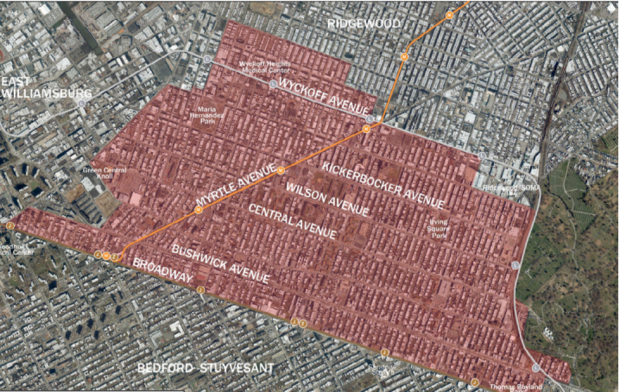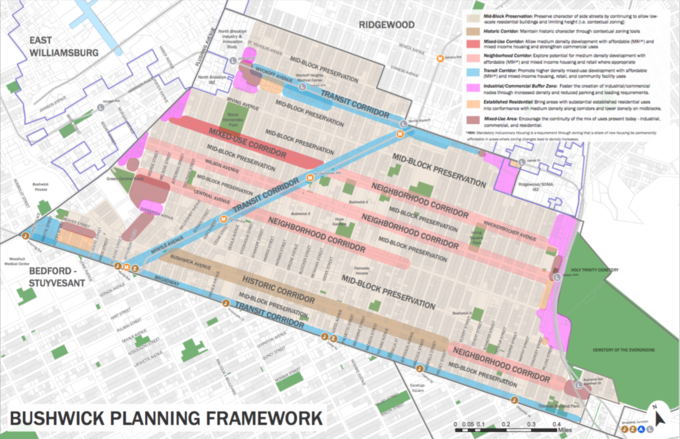Will Bushwick Rezoning Proceed? City Refuses to Consider “Downzoning”


BUSHWICK — The Bushwick rezoning came to a standstill on Friday, after Mayor Bill de Blasio’s administration refused to incorporate the Bushwick Community Plan’s Environmental review as part of its rezoning proposal.
What this means, Councilmember Antonio Reynoso’s office told Bklyner, is that the status quo and current trends of development in the area will continue – the worst of all possible outcomes.
A predominantly working-class neighborhood with a large immigrant population, Bushwick has been at the forefront of Brooklyn’s gentrification in recent years. According to a 2016 NYU Furman Center report, Bushwick is among the fastest gentrifying neighborhoods in the city with a 44% spike in average rent between 1990 and 2014.
The Bushwick Community Plan
In 2014, the Department of City Planning (DCP) was asked to support a community-led planning process to outline stakeholders’ hopes and priorities for the area. Council Members Antonio Reynoso, who is also a candidate for Brooklyn Borough President, and Rafael Espinal, along with Community Board 4, initiated the planning process, the Bushwick Community Plan (BCP), in response to concerns regarding out-of-character development and resident displacement, and a lack of affordable housing.
After four years of planning, The BCP, which was submitted in September 2018, calls for down-zoning of the mid-block and up-zoning of certain corridors, declaring some areas historic districts, and investing in open space and health resources. It was created by residents, nonprofits and local politicians who were upset by the displacement of longtime Bushwick residents.
In April 2019, DCP presented its rezoning plan, the Bushwick Neighborhood Plan, which did not completely follow the outline of the BCP, and included manufacturing in residential developments, more market-rate housing, and only provides the Mandatory Inclusionary Housing-required amount of affordable housing.
The City Pushes Back
In December, Councilmembers Antonio Reynoso and Rafael Espinal demanded that the city incorporate their plan as an alternative for the city’s environmental review process, which produces the environmental impact statement (EIS). EIS is a document that analyzes the potential impacts of a land-use change and is required before the Uniform Land Use Review Procedure (ULURP), a public review required before land-use changes, like rezonings, to be approved and can start.
On Friday, Deputy Mayor Vicki Been wrote a letter to Reynoso and Espinal, saying the Bushwick Community Plan did not incorporate the opportunity for new affordable housing:
“I am deeply concerned that the Bushwick Community Plan calls for ‘No more total units than the no-action scenario would produce, unless those additional units are deeply affordable.’ This approach is fundamentally a downzoning. It would reduce density significantly in many areas while spurring the creation of few new homes, deeply affordable or otherwise, in others. These outcomes run counter to the city’s goals of the rezoning, which would be to encourage new-mixed-income housing to prevent displacement spurred by current market forces while promoting a diverse, healthy and inclusive neighborhood and city. For this reason, the city does not support the inclusion of the environmental review of the Bushwick Community Plan in our environmental review.”
Yesterday, Reynoso and Espinal wrote a letter to the city in response, emphasizing that the Mayor’s decision to walk away from Bushwick is “shameful,” and “a continuation of discriminatory housing policies,” and continues the cycle of government neglect, ignoring the voices of the community.
“The plan increases the overall housing capacity of the neighborhood, allowing all the market-rate development potential that exists today, while mapping mandatory inclusionary housing to ensure that increased density results in affordable housing, and identifying where density makes sense, primarily along transit corridors, characteristics that are completely in line with the de Blasio housing agenda,” the letter stated. “We fundamentally reject Deputy Mayor Been’s assertion that this is a downzoning … We will not be extorted into taking more density simply to receive what we already deserve.”

What Now?
While the councilmembers were not surprised by the outcome, they hoped for the better.
“I think what’s unfair about this whole situation, is that for many years, the community has worked to create a plan that the mayor’s office would use to move the rezoning forward and the administration has been a part of those meetings and it gave us the impression that the process was going to be respected in the end,” Councilmember Espinal told Bklyner. “The letter that was sent out yesterday is our last resort and final plea for the administration to come to their senses and that the community plan should be respected.”
Espinal said in the worst-case scenario nothing changes: current zoning in Bushwick already allows developers to build types of housing that are out of character in the community and the neighborhood will continue to see the influx of luxury buildings and historic corridors being destroyed.
“I believe the [city] wants to maximize affordable housing in housing that’s being built and building more density in Bushwick to ease the housing crisis,” said Espinal, however, he believes they did not propose a responsible number of units in the DCP’s plan. The city’s proposed rezoning of Bushwick would lead to an increase of some 5,000 units of housing, and the community plan would have 2,000 or so units, all affordable.
“We find this news incredibly frustrating, disappointing, and contradictory, given the ongoing efforts to address the impact of development across the city,” Community Board 4 wrote in a statement yesterday. “This decision allows for the continuation of decades of neglect and disenfranchisement, furthering discriminatory policies by unfairly characterizing a well-thought-out and carefully crafted community vision as a downzoning. The community’s plan endeavors to retain the low density, family-oriented housing common throughout the neighborhood, as well as, strategically direct the same growth possible within the current zoning framework to more appropriate areas.”
In terms of what’s next, the offices of councilmembers, the BCP Steering Committee, and Brooklyn Community Board 4 will gather to discuss how to proceed.
We have reached out to the DCP for comment.
Update: it was clarified that the BCP plan called for both down-zoning and up-zoning of different areas.



